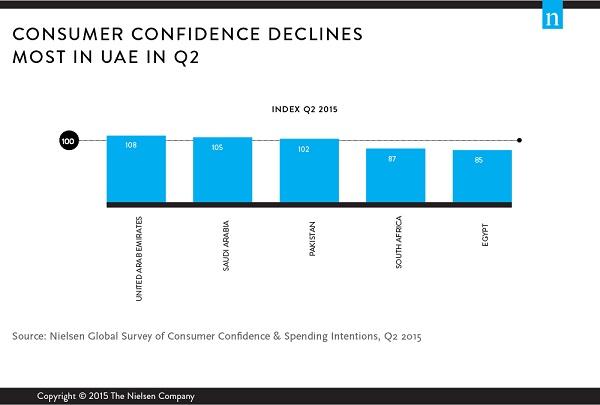 Consumer confidence in the United Arab Emirates (UAE) had the highest index of five countries measured by Nielsen in Middle East/Africa region (108), but the country’s confidence decreased seven points from the first quarter—the biggest quarterly decline in six years. Confidence also declined in Egypt by five points to 85 and in Saudi Arabia by two points to 105. Confidence levels in Pakistan (102) and South Africa (87) were unchanged from the first quarter.
Consumer confidence in the United Arab Emirates (UAE) had the highest index of five countries measured by Nielsen in Middle East/Africa region (108), but the country’s confidence decreased seven points from the first quarter—the biggest quarterly decline in six years. Confidence also declined in Egypt by five points to 85 and in Saudi Arabia by two points to 105. Confidence levels in Pakistan (102) and South Africa (87) were unchanged from the first quarter.
“In the United Arab Emirates, job security concerns are amplifying as lower oil prices can fuel expectations of government spending cuts,” said Arslan Ashraf, managing director, Nielsen Arabian Peninsula. “Additionally, two key sectors of the economy—real estate and tourism—are showing signs of softening. As such, consumers are saving more and spending less, intending to pull back spending on new clothes, out-of-home entertainment and home improvements expenses.”
Regionally, while sentiment about job prospects edged up one percentage point to 45%, personal finances sentiment declined two percentage points to 58%, and immediate spending intentions declined three percentage points to 36% from the first quarter. Recessionary sentiment increased in four of five Middle East/Africa markets: Egypt and South Africa each increased three percentage points to 82% and 73%, respectively, and Saudi Arabia and the United Arab Emirates increased two percentage points to 45% and 41%, respectively. The lone quarterly relief was found in Pakistan, where 71% of those surveyed felt that their country was currently in an economic recession, three points lower than the previous quarter.
Quarter-on-quarter discretionary spending and saving intentions changed marginally in the region across most lifestyle categories. Intentions to save declined two percentage points to 37%, but plans to invest increased two percentage points to 12%. Paying debts was the priority for 22% of respondents, an increase of three percentage points, and spending on new clothes (27%) and holidays/vacations (19%) increased one percentage point each from the first quarter.


